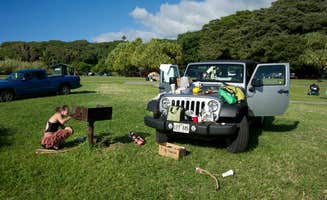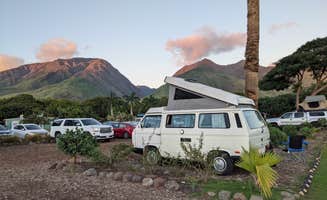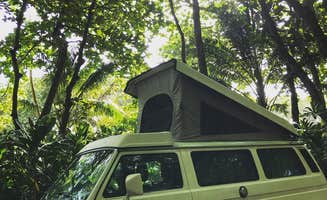RV camping near Wailuku, Hawaii offers several options for those exploring the 2nd-largest Hawaiian island. Maui's diverse microclimates mean campers can experience dramatically different conditions within short driving distances, from arid beach settings to cool 7,000-foot mountain elevations. While oceanfront RV sites are limited in supply, Maui campgrounds typically operate year-round with many sites requiring advance planning due to their popularity among both locals and tourists.
What to do
Hike to waterfalls: At Kīpahulu Campground in Haleakalā National Park, campers can access the Pipiwai Trail. "The most popular is the Waimoku falls that you reach by hiking through the bamboo forest up the Pipiwai trail. Camping at Kipahulu means that you can hit the trail early before the resort/day visitors make it to this side of the island," notes reviewer Stephanie Z.
Watch sunrise or stargaze: The elevation at Hosmer Grove Campground provides unique opportunities for sky viewing. "7,000 feet above sea level, you are literally up in the clouds. Amazing panoramic views of the pacific ocean and the crater right around the corner," writes reviewer Megan B. The campground's location is strategic for astronomical viewing as "the bird watching is wild. The confluence of water and mixed plants makes this a perfect spot for bird watching, including some rare and endangered birds," according to Ryan W.
Explore black sand beaches: Camp near distinctive volcanic beaches for early morning access before crowds arrive. "The black sand beach is lovely, but when we went in February, it was a bit too dangerous to enter the ocean. There are definitely rocks all around, and it's the side of Maui where the waves are larger, so be careful," cautions Raphaela H. about her stay at Waiʻanapanapa State Park Campground.
What campers like
Outdoor showers: The facilities at Camp Olowalu are frequently praised. "The outdoor showers at Camp Olowalu resort are worth the stay in and of themselves. They are works of art, frankly," writes Shari G. Another camper elaborates: "The amenities are GREAT. The showers are enclosed, they have benches and hooks to put your things down on and they have hot and cold water."
Less crowded beaches: Molokai offers a quieter alternative for motorhome camping. "Molokai is not only beautiful, but it has the full range of landscapes, from beach to mountains, from desert-like atmosphere to rain forest. The beaches are not only full of beautiful white sand, but lacking crowds of people!" shares Alejandro G. about Pālāʻau State Park Campground.
Available water sources: Having access to drinking water is important when RV camping in Hawaii's climate. At Hosmer Grove, "There's pit toilets with sinks, running water and soap to wash up afterwards, as well as a water fountain, picnic tables and grills," notes Jordan T., which is particularly valuable for RVs without large water tanks.
What you should know
Temperature variations: Elevation dramatically affects camping comfort in Maui. "When people say it's cold up there, it's COLD. Our van was too old to make it up to Hosmer Grove, so we hitchhiked up and brought a 2 person tent for the night," warns Jordan T. "Be prepared with a warm sleeping bag, long sleeves, long pants, socks and maybe a warm hat."
Wind exposure: Many camping areas lack natural windbreaks. A camper at Camp Olowalu warns, "Beware the wind!!! Because it's open air with no shielding trees, sooo many people evacuated to sleep in cars or resigned to/woke up to collapsed tents because of high winds."
Noisy roosters: Wildlife can affect sleep quality at many Maui campgrounds. "Unfortunately camp olowalu is overrun by roosters, so you aren't going to get a good night of sleep," notes Carrie S. Another camper advises, "Like most camping in Hawaii, bring your earplugs for the roosters."
Tips for camping with families
Choose sites with amenities: Families benefit from developed facilities. "Each tent spot has its own grill and picnic table, and is close to garbage bins, the beach and showers/toilets," notes a reviewer about Camp Olowalu, making it suitable for family camping near Wailuku.
Consider cabins for longer stays: Waiʻanapanapa State Park Campground offers cabin options. "We stayed in a cabin, which are usually two-night minimum, but we planned our trip around a 1-night only availability to get around this rule (~$100/night)," shares Raphaela H. "The cabin has water and electricity, but no AC, so we just slept with the windows open and it was comfortable."
Plan for early mornings: Many family-friendly activities are best enjoyed early. "I recommend this campground due to the location, easy access to waterfall hikes and beach front camping," writes Emmanuel M. about Kīpahulu, where getting an early start helps avoid crowds at popular attractions.
Tips from RVers
Level site scarcity: Finding flat parking for RVs can be challenging. Jordan T. notes, "The campsites we saw don't really have vegetation between them, but you're here for the location and the beach, and there aren't any other economical overnight options in the area."
Campervan parking considerations: At Waiʻanapanapa, a reviewer notes "The area is for both tent and car camping, and there's no separate parking lot for tent campers since it is a bit of a walk from the visitor's parking lot." This means RVs may need to use designated parking areas rather than camping directly at tent sites.
Water access planning: Availability of water hookups varies widely. At Kipahulu, "There's no running water, but two small buildings with pit toilets inside and hand sanitizer," advises a camper. "While there's running water in the bathrooms at the service center, as well as a water fountain to fill up your water bottle there, there's no faucet or anything that you could use to fill up a big water jug."




